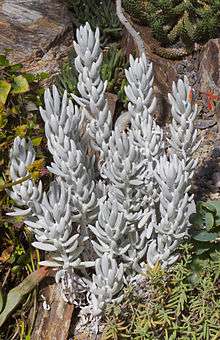Senecio haworthii
| Senecio haworthii | |
|---|---|
 | |
| Woolly senecio | |
| Scientific classification | |
| Kingdom: | Plantae |
| (unranked): | Angiosperms |
| (unranked): | Eudicots |
| (unranked): | Asterids |
| Order: | Asterales |
| Family: | Asteraceae |
| Tribe: | Senecioneae |
| Genus: | Senecio |
| Species: | S. haworthii |
| Binomial name | |
| Senecio haworthii (Sweet) Sch.Bip. | |
| Synonyms | |
|
Cacalia haworthii Sweet | |
Senecio haworthii also known as Woolly senecio is a perennial dwarf shrub of the Senecio genus that grows in South Africa usually between the altitudes of 900 and 1200 meters.[1]
History
Its first description was written by Adrian Hardy Haworth, in Miscellanea naturalia, 1803, p. 189, with the name of Cacalia tomentosa. Haworth stated that he had received the plant, introduced eight years before, from the Stockwell Botanical Garden of his friend Benjamin Robertson.[3]
Description
The leaves are remarkably densely felted, so much so that the felt can be stripped off, dried, and used as tinder. The plant is accordingly called "tontelbos" in Afrikaans. The word means "tinder bush". Though its flowers are nothing special to look at, the plant is striking, easily grown, and fairly attractive; a plucked stem, or even a leaf, can be stuck into warm, not-too-dry earth, where it will strike root without special attention. Like most Richtersveld plants it does not do well in wet soil, but is not in general a demanding garden subject.[4]
| Wikimedia Commons has media related to Senecio haworthii. |
 In its habitat, Richtersveld, South Africa
In its habitat, Richtersveld, South Africa- Leaves, showing dense, tight, felted surface
Culture
Like in nature, Senecio haworthii needs well-drained sandy loams, rare water and full sun.
References
- 1 2 "Senecio haworthii (Sweet) Sch.Bip. record n° 98154" (HTML). African Plants Database. South African National Biodiversity Institute, the Conservatoire et Jardin botaniques de la Ville de Genève and Tela Botanica. Retrieved 2014-04-02.
- ↑ International Organization for Plant Information (IOPI). "Plant Name Search Results" (HTML). International Plant Names Index. Retrieved 2008-05-24.
- ↑ Senecio haworthii - SANBI article
- ↑ Senecio haworthii - Succulent Encyclopedia
External links
![]() Media related to Senecio haworthii at Wikimedia Commons
Media related to Senecio haworthii at Wikimedia Commons